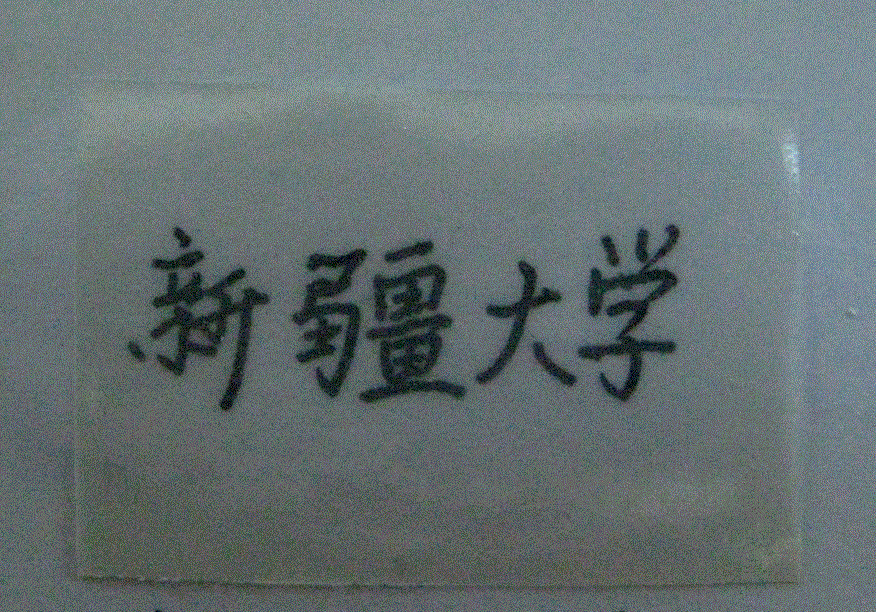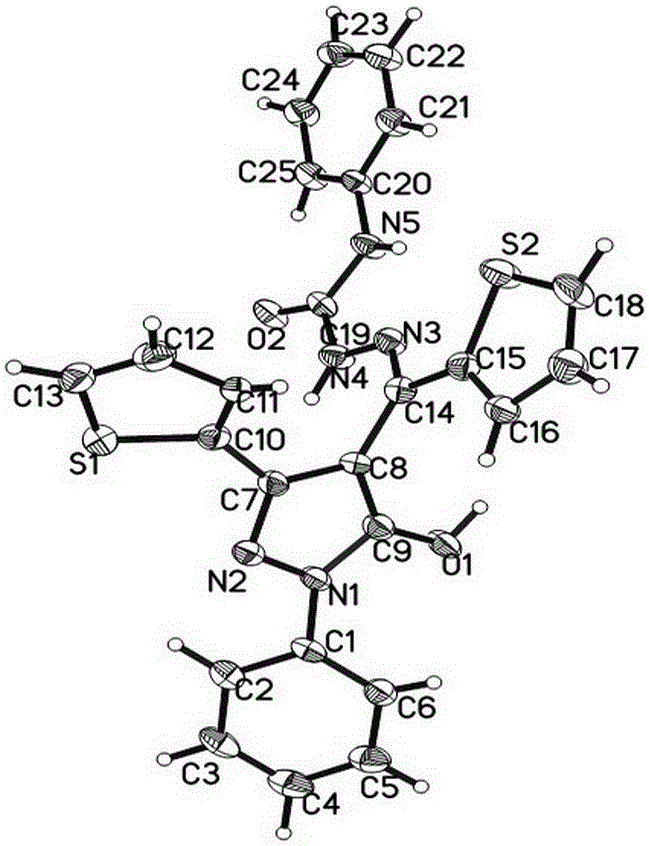Preparation and application of thienyl-containing pyrazolone derivatives and their polymer films
A thienyl pyrazolone and polymer film technology is applied in the field of preparation and application of thienyl pyrazolone derivatives and polymer films thereof, and can solve the problems of inconvenient popularization and application of solid powder crystals, fatigue resistance, The thermal stability of photosensitivity cannot meet the problems of practical application, and achieves the effects of good photochromic performance, high sensitivity and simple method.
- Summary
- Abstract
- Description
- Claims
- Application Information
AI Technical Summary
Problems solved by technology
Method used
Image
Examples
Embodiment 1
[0017] Example 1: Preparation of 1-phenyl-3-thiophene-4-thiophene methylene-5-hydroxypyrazolone phenylsemicarbazide [PD(2 -Th)P-PSC]
[0018] Weigh 1.7627g (5.0mmol) 1-phenyl-3-thiophene-4-thienoyl-5-hydroxypyrazolone [PD(2-Th)P-PSC] and 0.7563g (5.0mmol) phenyl Put semicarbazide (PSC) in a round-bottomed flask, use 5mL ethanol as solvent, 5-7 drops of glacial acetic acid as catalyst, heat to 80°C with magnetic stirring and reflux for 2h, filter with suction, recrystallize, and dry to obtain 2.1368g of white product ( 4.4mmol), yield 88%, melting point: 209.1-210.0°C. The white powder turns yellow after being irradiated with 365nm ultraviolet light; the yellow powder turns from yellow to white after being irradiated with visible light.
[0019] The synthetic route and photochromic mechanism of this type of compound are as follows: figure 1 shown.
Embodiment 2
[0020] Example 2: Preparation of PD(2-Th)P-PSC / PS composite film by method one
[0021] At room temperature, under the condition of magnetic stirring, slowly add 0.25g polystyrene (PS) into 2mL toluene, stir continuously to fully dissolve PS, and form a clear solution. Then, under the condition of avoiding light, 0.02 g of PD(2-Th)P-PSC white powder was slowly added into the clear solution, superceded in the ultrasonic instrument for 5 minutes, and continued to stir for 10 minutes to make PD(2-Th)P-PSC The PSC dispersed well into the clear solution, resulting in a co-suspension. After defoaming by standing in the dark, slowly pour the blended suspension into a clean Petri dish. The PD(2-Th)P-PSC / PS composite polymer film was obtained by natural air-drying at room temperature for 24 hours in the dark, and the content of PD(2-Th)P-PSC was 8wt%. The film has good photochromic properties.
[0022] The optical photographs of PD(2-Th)P-PSC / PS composite films are as follows figu...
Embodiment 3
[0023] Example 3: Preparation of PD(2-Th)P-PSC / PS Composite Film by Method 2
[0024] Use an ordinary square glass sheet (20mm×20mm×2mm) as the substrate, clean and dry it before use. Fix the substrate on a spin coater, drop the blended suspension of PD(2-Th)P-PSC and PS prepared in Example 2 onto the substrate, rotate at a certain speed for 30s, and spin coat The solution was evenly spread into a thin film, and placed in the dark at room temperature to dry naturally to obtain a PD(2-Th)P-PSC / PS composite film with a PD(2-Th)P-PSC content of 8wt%. This film also has photochromic properties.
PUM
 Login to View More
Login to View More Abstract
Description
Claims
Application Information
 Login to View More
Login to View More - R&D
- Intellectual Property
- Life Sciences
- Materials
- Tech Scout
- Unparalleled Data Quality
- Higher Quality Content
- 60% Fewer Hallucinations
Browse by: Latest US Patents, China's latest patents, Technical Efficacy Thesaurus, Application Domain, Technology Topic, Popular Technical Reports.
© 2025 PatSnap. All rights reserved.Legal|Privacy policy|Modern Slavery Act Transparency Statement|Sitemap|About US| Contact US: help@patsnap.com



